Hi Guys, I thought I would show you my first attempt at a proper bit of furniture. We recently purchased a beautiful Gordon Russel
dressing table, see here: http://www.ebay.co.uk/itm/1960s-English ... 0558133282 As you
can see, a very elegant and fetching design with some lovely touches. SWMBO asked if I could make a matching stool and after a
quick look, said, yes, of course!!!
So, ordered up some Indian Rosewood ( it looked like the nearest match from the picture on the website) from exotic hardwoods
(great company and service BTW) but it looked very different to the rosewood of the stool when it arrived, I think the Santos
Rosewood would have been a better match. We decided to go ahead however, as the Indian Rosewood was gorgeous, almost ebony like,
with amazing lighter coloured grain patterns and a purpley hue to some of it.
I carefully scaled down the measurements of the dressing table to make sure the stool matched it in proportions and made my
cutting list. First job, fire up the bandsaw and rough cut the stock to size. The more i thought about the table and its
construction the more I realized that this was not going to be straightforward. The legs are elliptical tapered shapes with
rounded off corners, of two different profiles. The side rails are curved and profiled and the top has a small bead around the
edge to avoid showing end grain. Talk about in at the deep end........Still, I like a challenge !
I started making the legs first, and used my taper jig ( taken from " The resourceful woodworker" a fantastically useful book if
you can get it..)
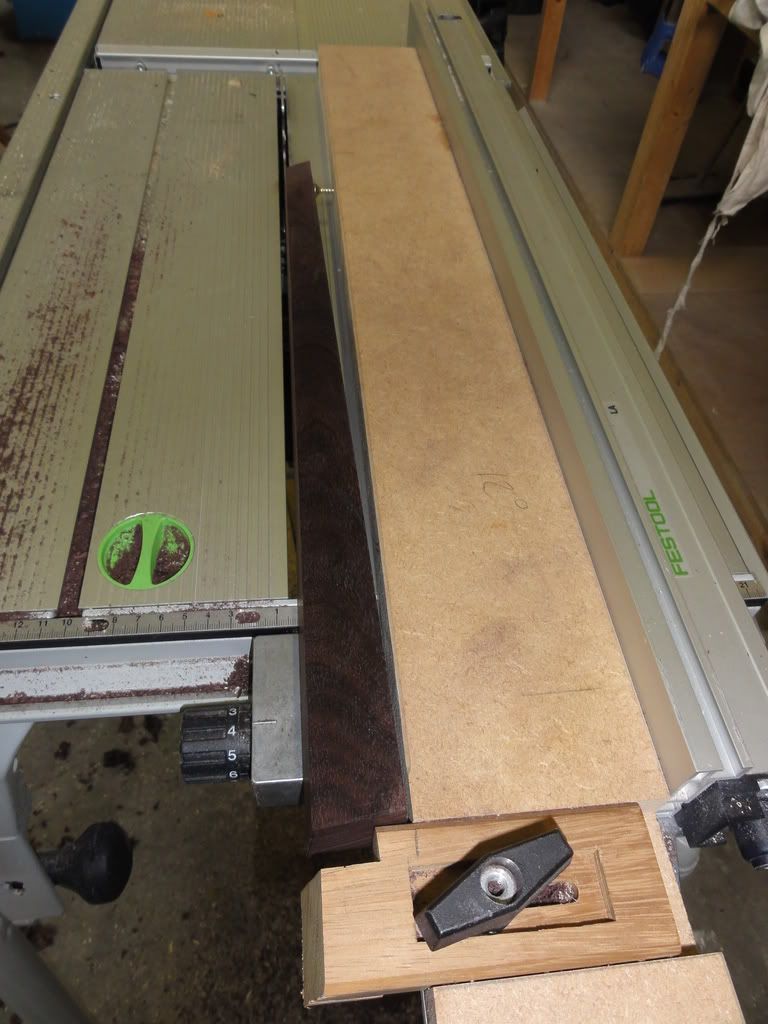
The first pass was easy, but both planes required tapering and here was where it got tricky....... I eventually
figured out how to pack the leg and reverse the cut, also allowing for the thickness of the blade using the off cut. However,
before I started on the rosewood, as there was no spare, I decided to make a couple from softwood so I had the method and jig
correctly sorted out in advance. This proved a good decision as I went through several softwood versions while figuring it out.
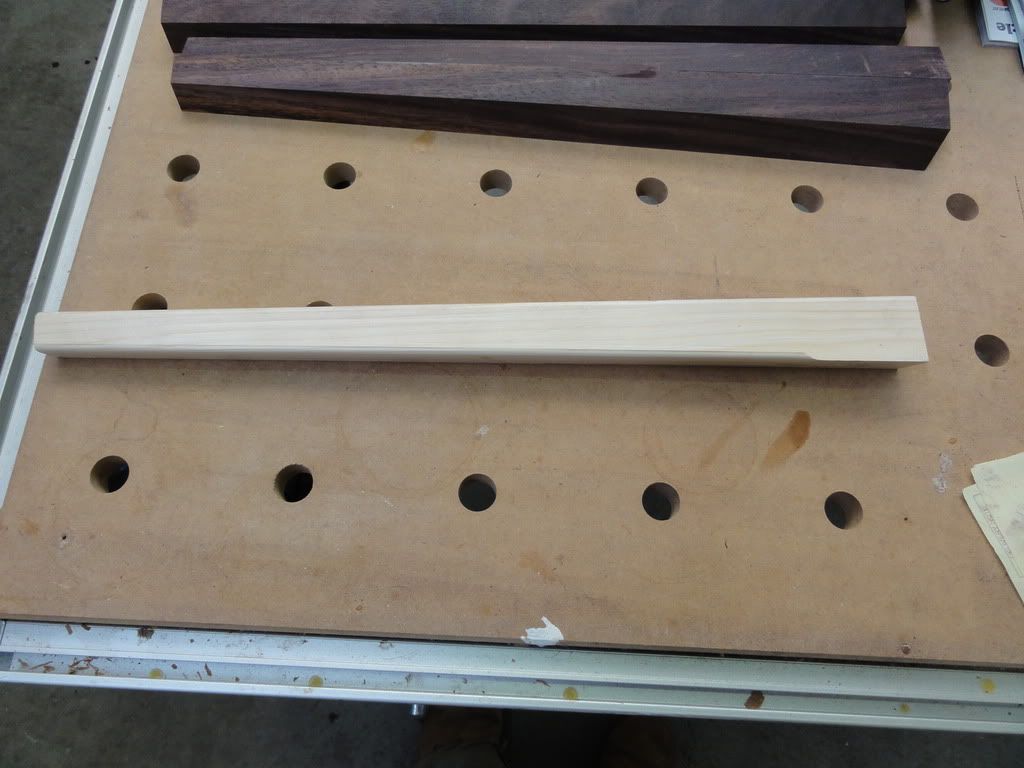
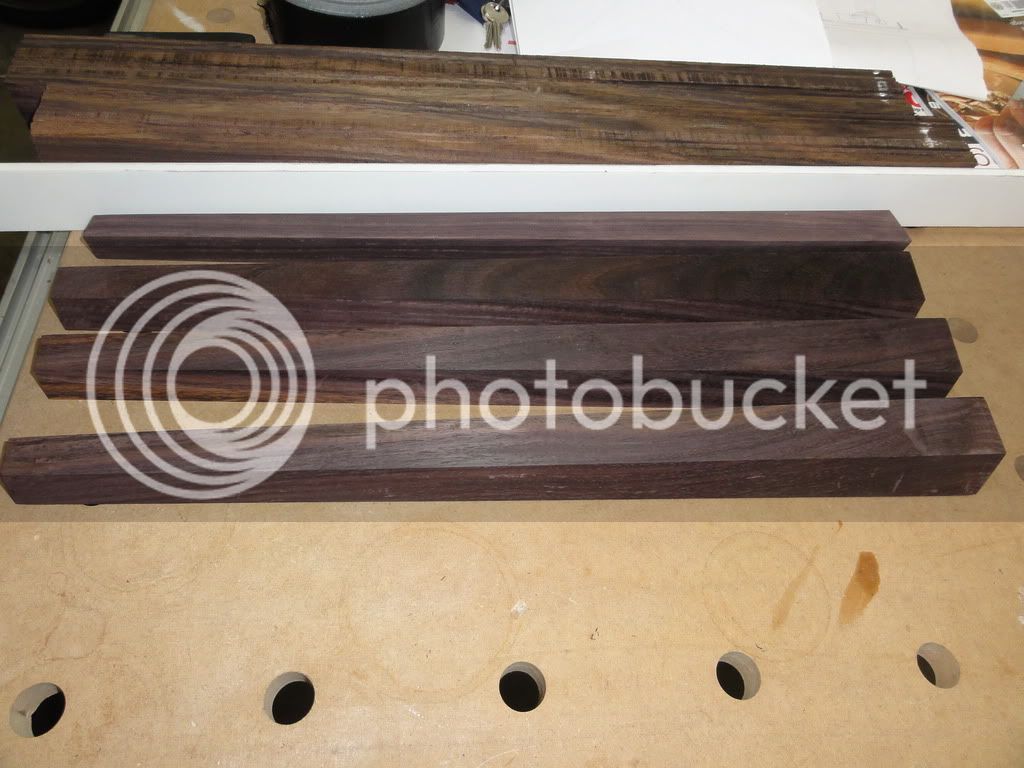
Eventually I was happy that I had it sussed and with bated breath cut the first leg for real. It worked!!! I see Woodmonkey used a
jointer to do his tapered legs in the thread about his table, so I might look in to that method as well. After this, I then had to
plane 2 faces of each leg a few degrees under a right angle at the top, and lose it down the taper, to follow the line of the
curved side pieces. Not easy clamping a tapered in 2 planes leg in a vice solidly enough to plane rosewood effectively.... a few
choice words were uttered as the legs kept working themselves loose from the packed and shimmed arrangement as I planed
particularly forcefully..!!! Eventually though, it was all done.
Next stage was to make the side rails. As they were curved,I decided to cut the stock thicker and actually cut the shape of the
curve on the bandsaw. I used a piece of Corian held at tension, to give the required curve to trace out with a felt pen on to the
wood.
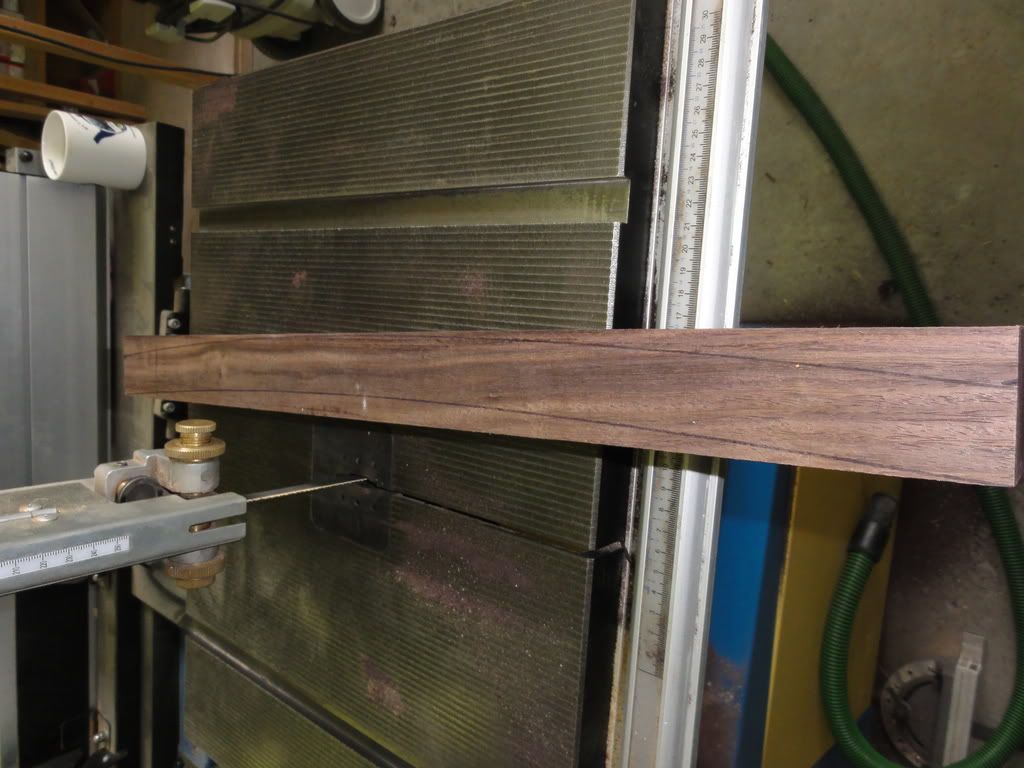
When they were cut out roughly, I planed off the excess as best I could
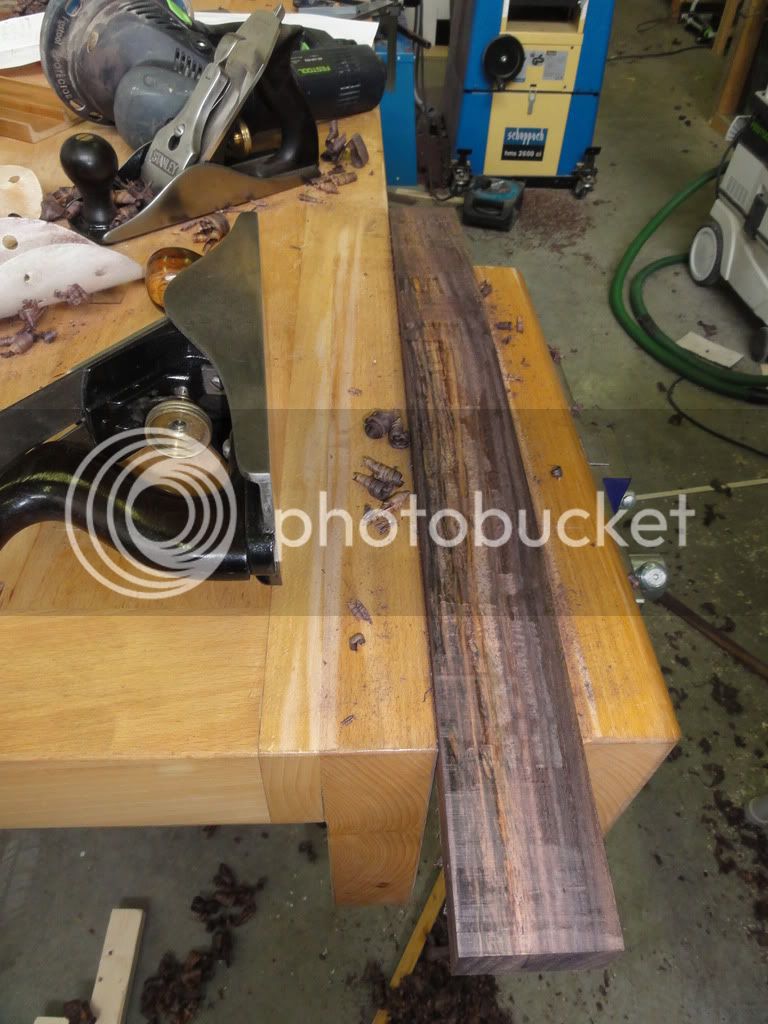
and then set to work with the Rotex sander and some 40 grit paper to shape the inner and outer curves properly. This was not as easy as it sounds and took ages, and it is really difficult to get the curve right in all the dimensions, especially as its all too easy to take off more than you needed in one area with the Rotex and some 40 grit...Once I had the shape right, i worked back up to 240 grit to smooth it all off.

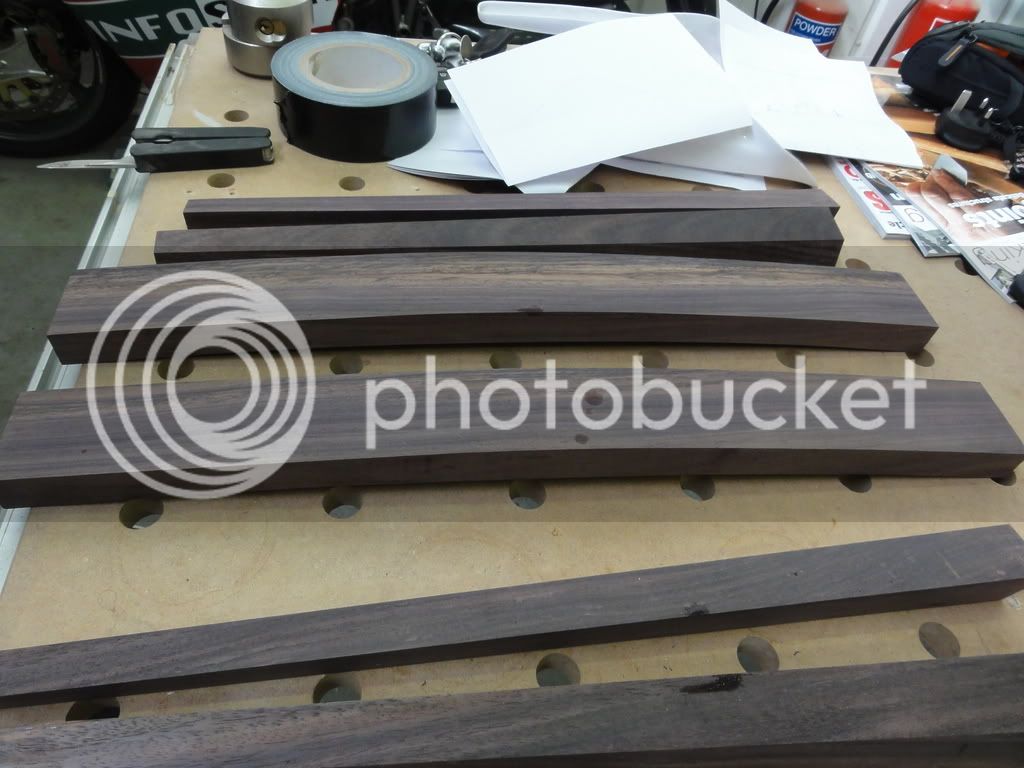
The next stage was the top. I had to resaw and thickness the stock to about 12mm each piece, to get the required size pieces to
make a big enough panel for the top. After jointing up on the machine and finishing with the big number 6 stanley, they dry fitted
nicely, so I used the smallest dominoes and glued them together and clamped up to dry.
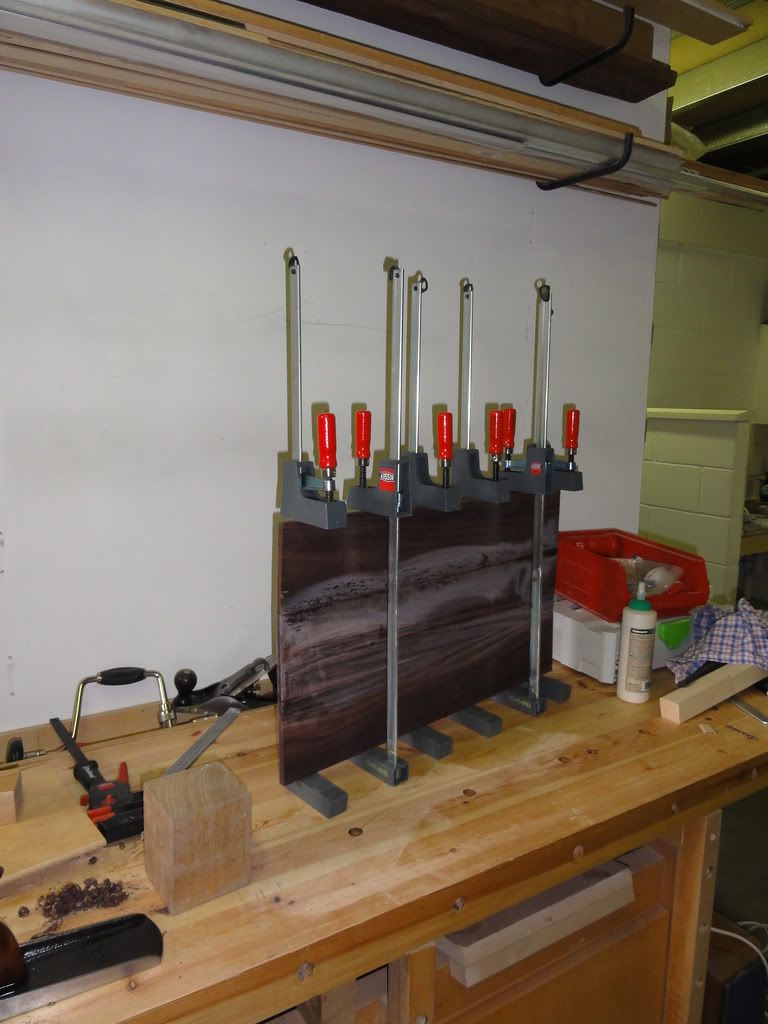
and the finished top piece

Then came the first pause for reflection.... how was I going to strongly and accurately join it all together. I must confess to
not really thinking this through properly at the beginning and now realized that using the domino jointer was going to be really
tricky, due to the fact that not one of the faces were parallel, at right angles to one and other, or straight....hmmmmm.. I
posted in the general forum and the general consensus was use the domino and some careful packing and shimming. Again, I was
careful to try it on some scrap first, and then on the real thing. It was tricky and awkward, but worked...phew...
Then, on to cutting the correct angle to match the taper of the legs and the trapezoid shape on each end of the side rails.
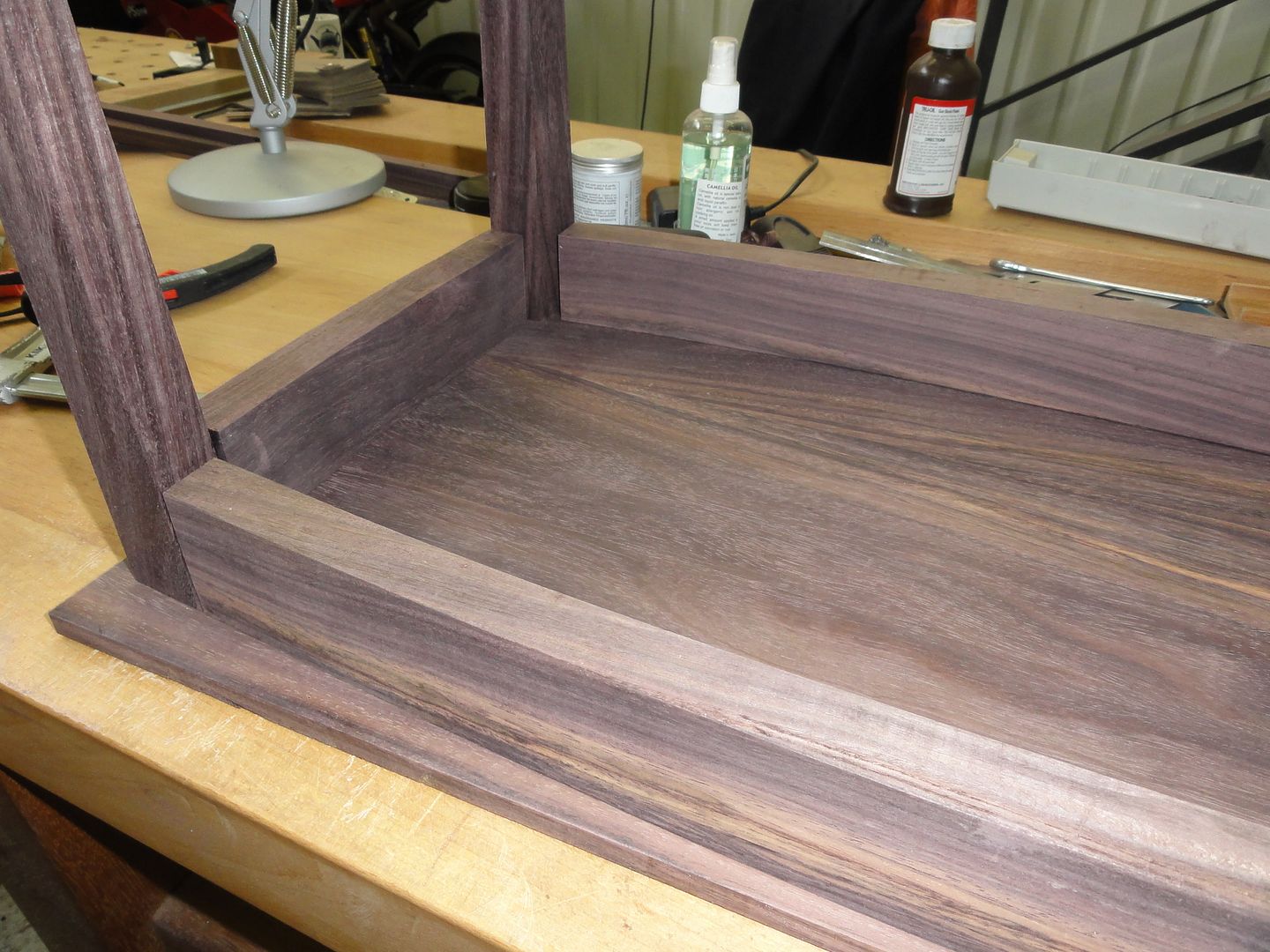
This again was not easy as it a raked and angled cut on a curved piece of stock, that varied slightly on each leg, as I had planed
these by hand. I ended up creeping up on each cut individually until they all fitted just right.
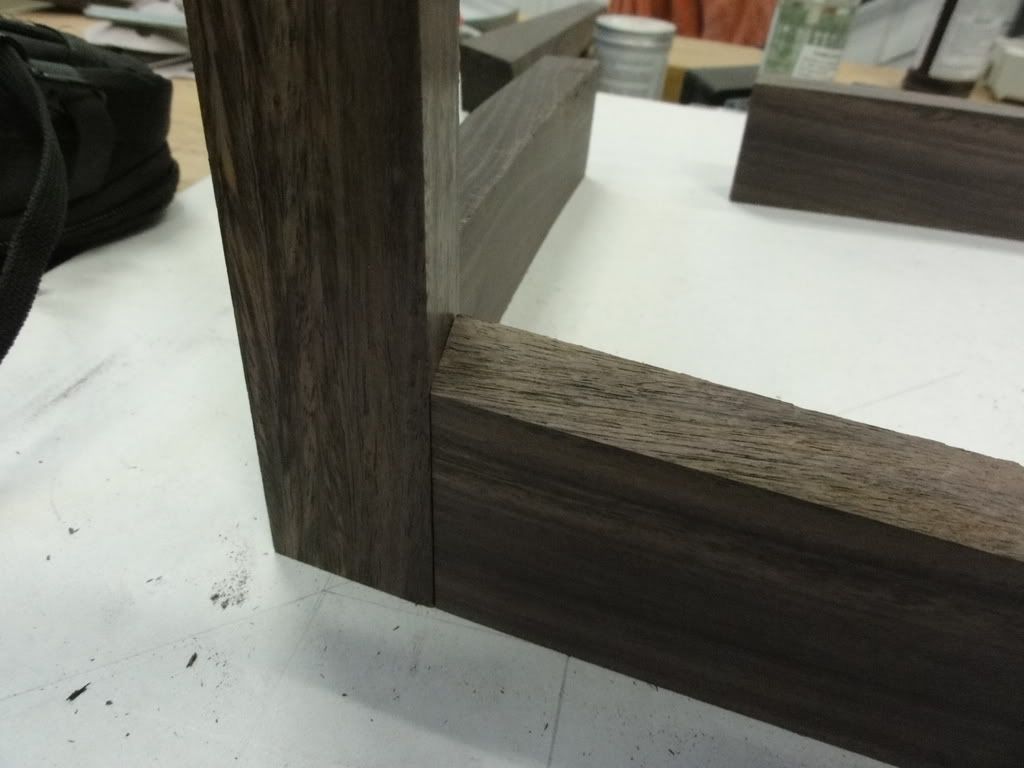
Then, it was the dry assembly to check how it fitted, and it all looked good.
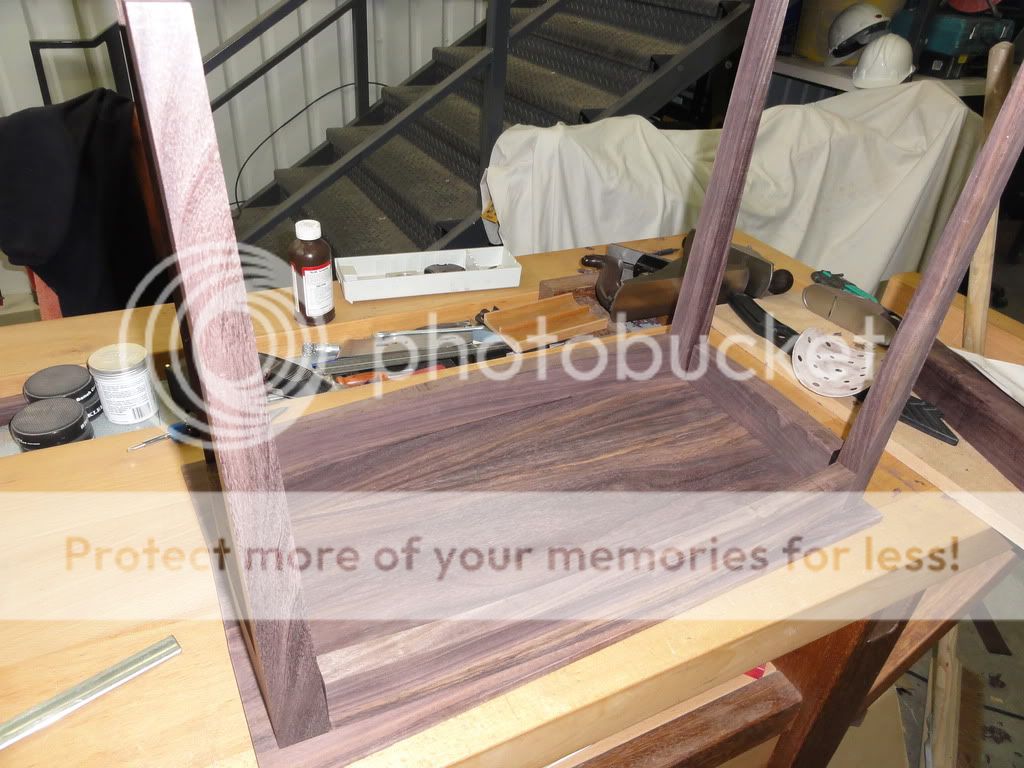
At this point I decided that I should also have a centre rail support, as the stool was going to be sat on, the top was only 12mm
thick and there was the danger that it would sag under the weight of SWMBO ( A svelte 9 stone I hasten to add....! but even so,
possibly enough to break the glue join) . So from the one remaining off cut, I made a centre rail, with a nice angled face, and
dominoed it to the side rails.
I also decided that I would need to provide some additional strength to the whole thing, and also
the largest glueing area possible for the top, which would just have to be glued on. So, I decided to rout out down to 12mm depth
the frame, using my Festo adjustable routing template ( very useful bit of kit) ,
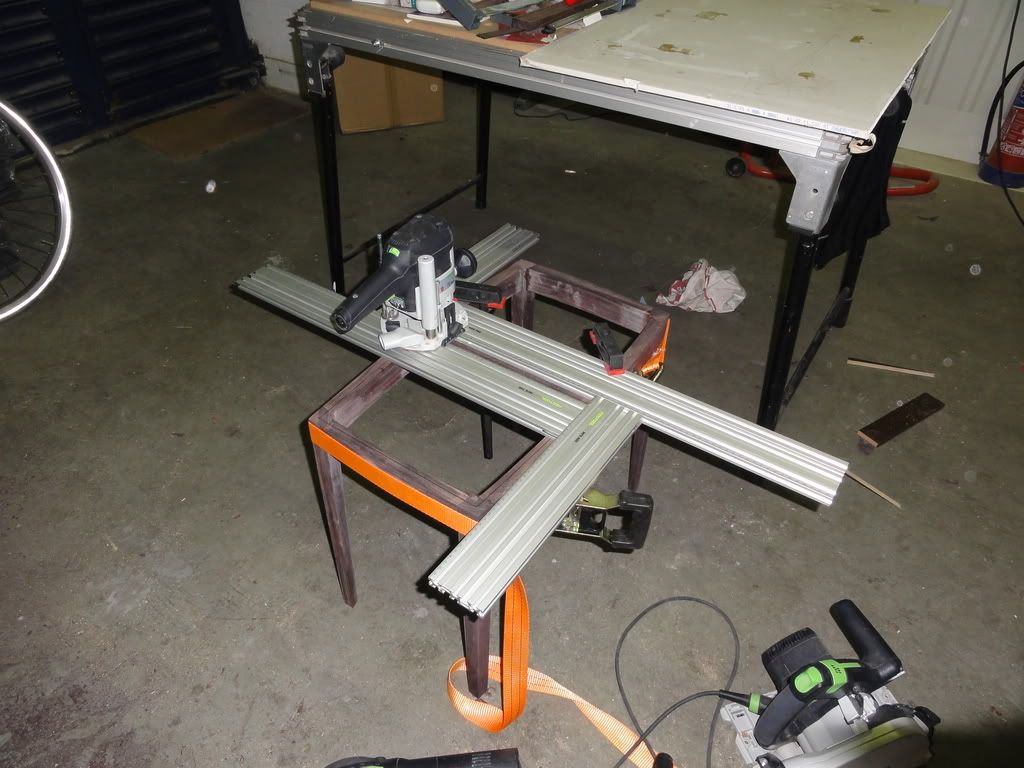
and drop in two panels made from some Wenge veneered MDF , which went with the rosewood quite nicely. This meant that the top could now be glued down completely over its whole area, rather than just where it met the rails.
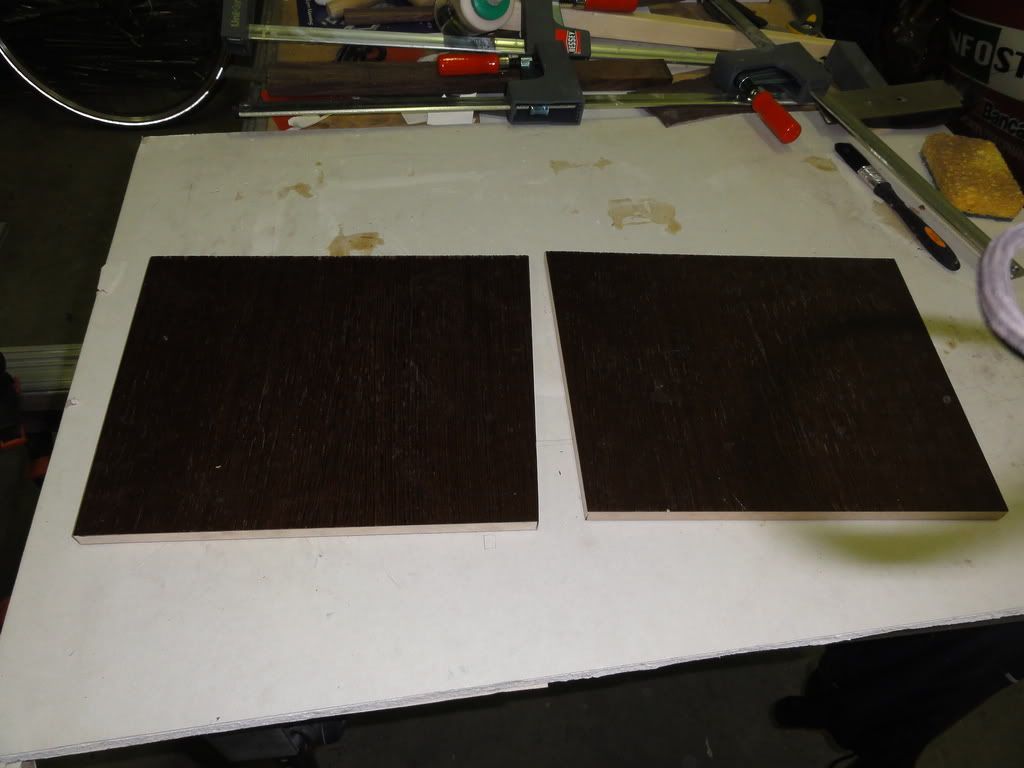
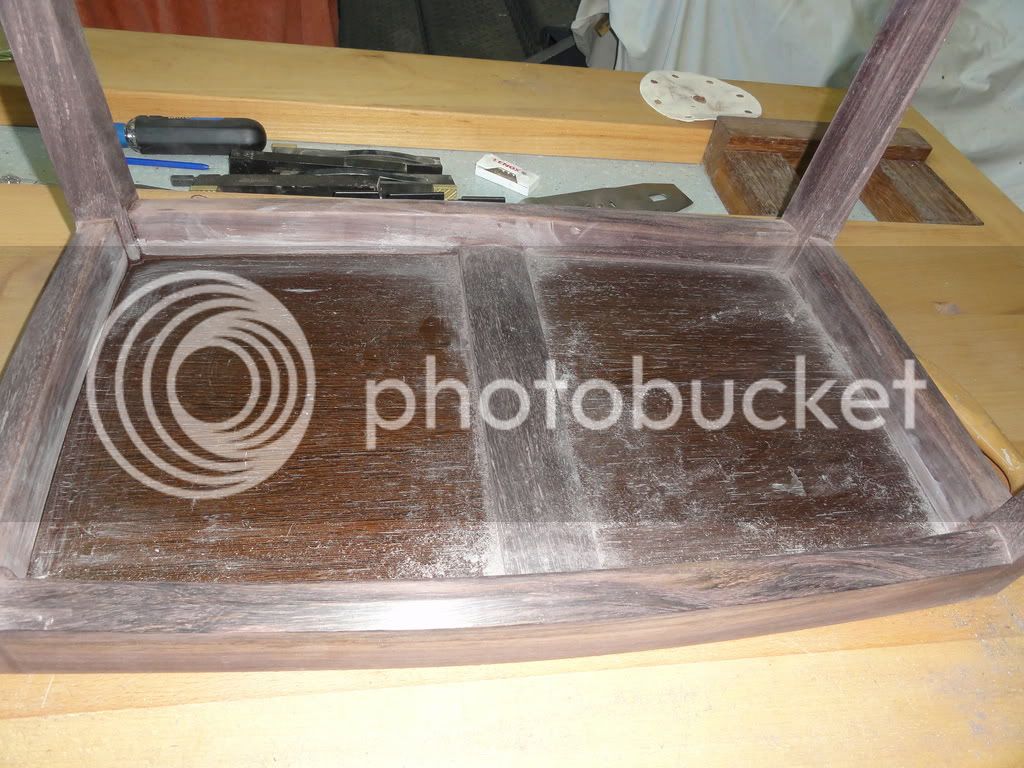
This done, I glued it all up and used a ratchet and nylon strap to clamp it all together overnight, using Titebond ultimate.
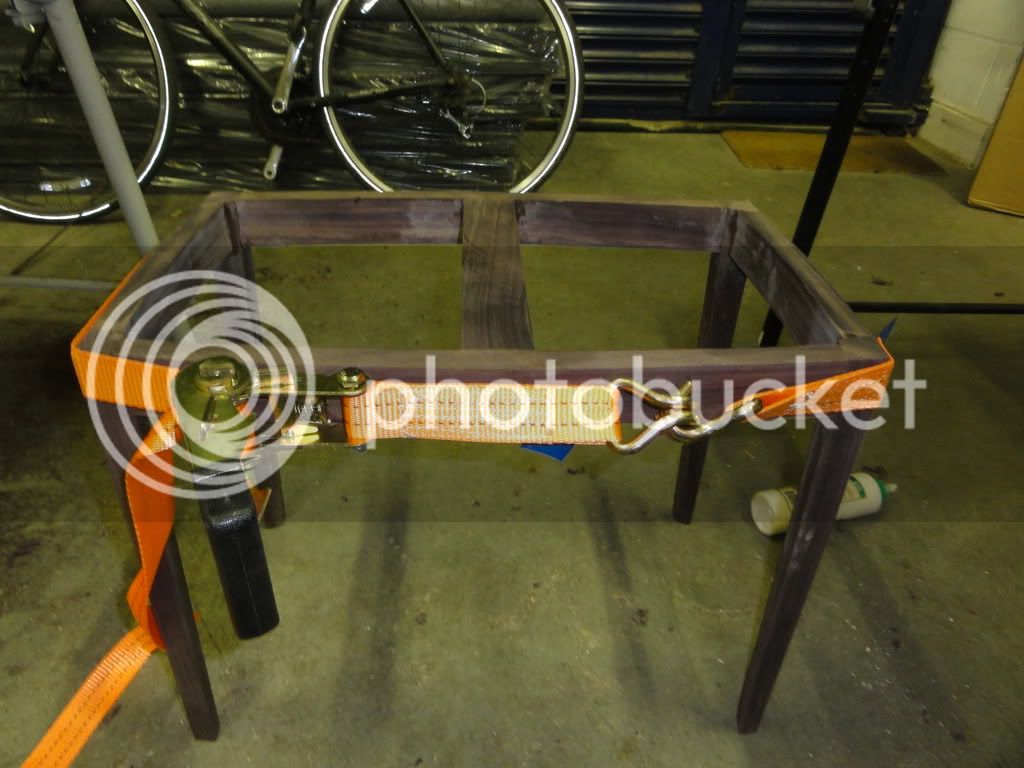
Once this was glued, the last piece of construction was to fit the top to the structure.
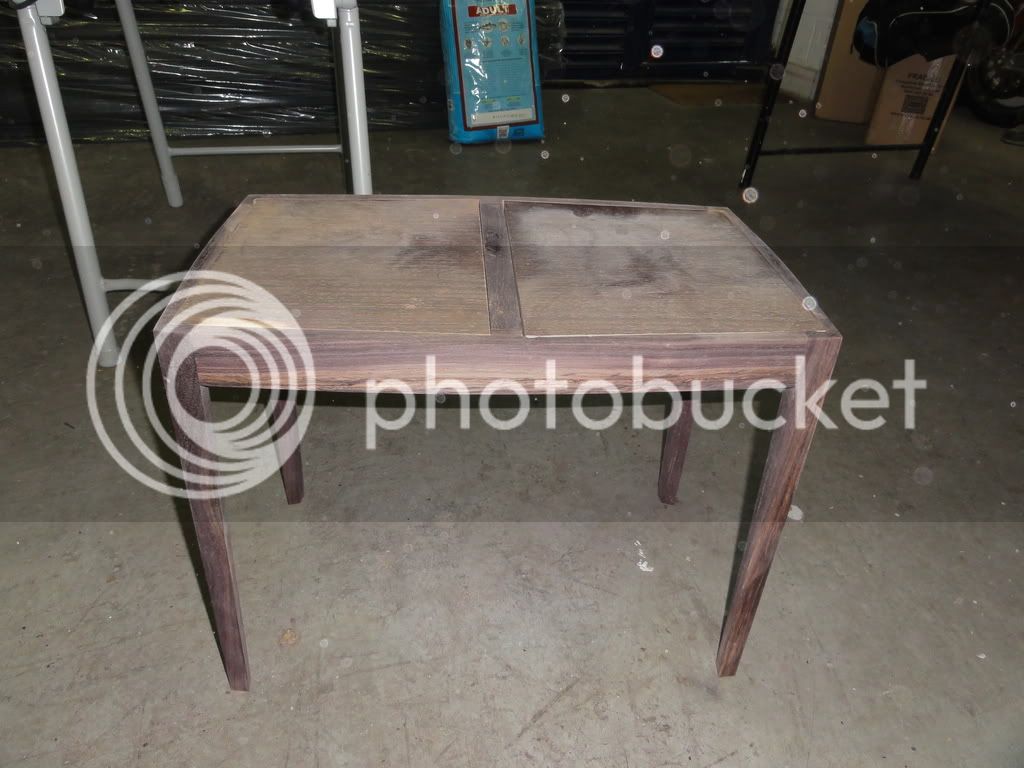
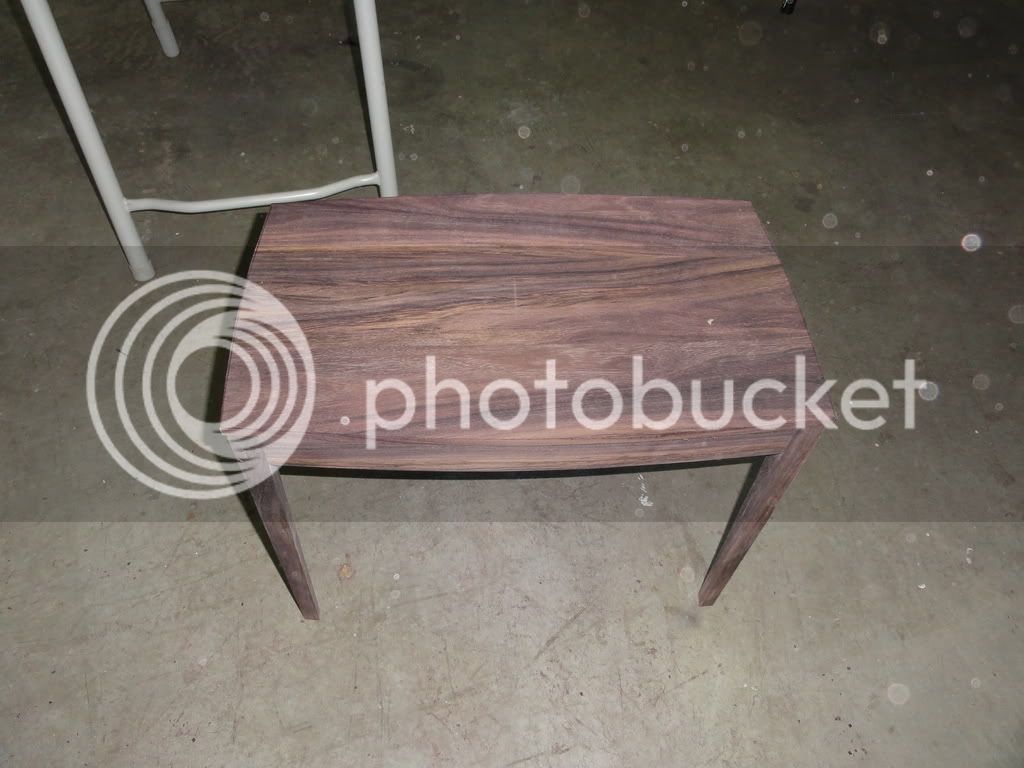
I cut it slightly oversized on the bandsaw,
after laying it over the frame and then glued up. I cut a piece of ply to fit under the stool, to give me something to clamp to,
and then set about clamping the top on. I think I used all my clamps, as you can see from the picture, there was not much room
left around the edge! I left it for nearly 2 days before unclamping.
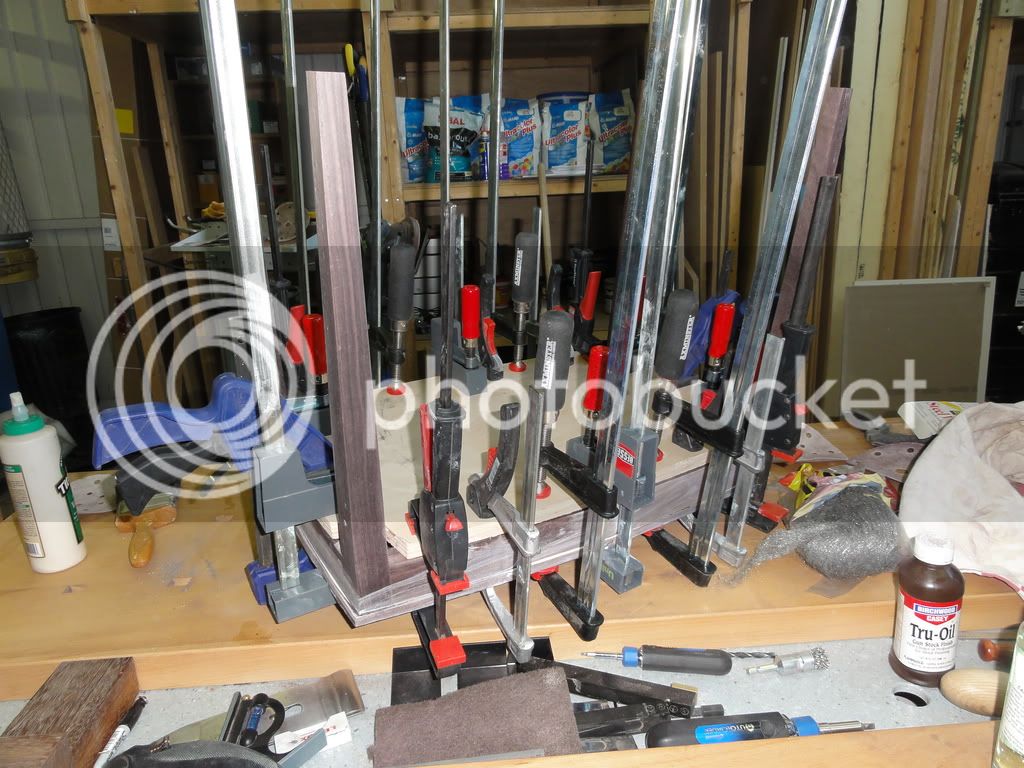
Then, I used a bearing guided straight cutter to follow the shape of the frame and routed off the overhang.
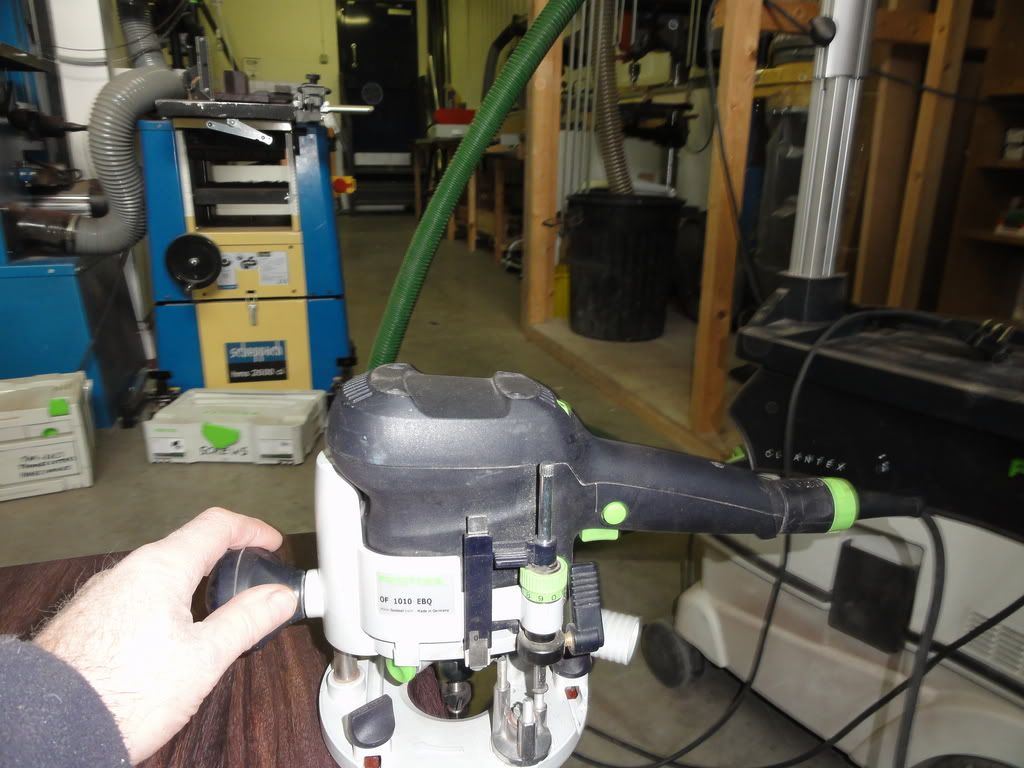
After that, I used a small radius bearing guided cutter, to round over the edge. I had considered replicating the shaped bead used on the original, but was unsure how easy it would be to bend to shape and also the end grain did not look at all bad, so in the end decided not to
include this feature.
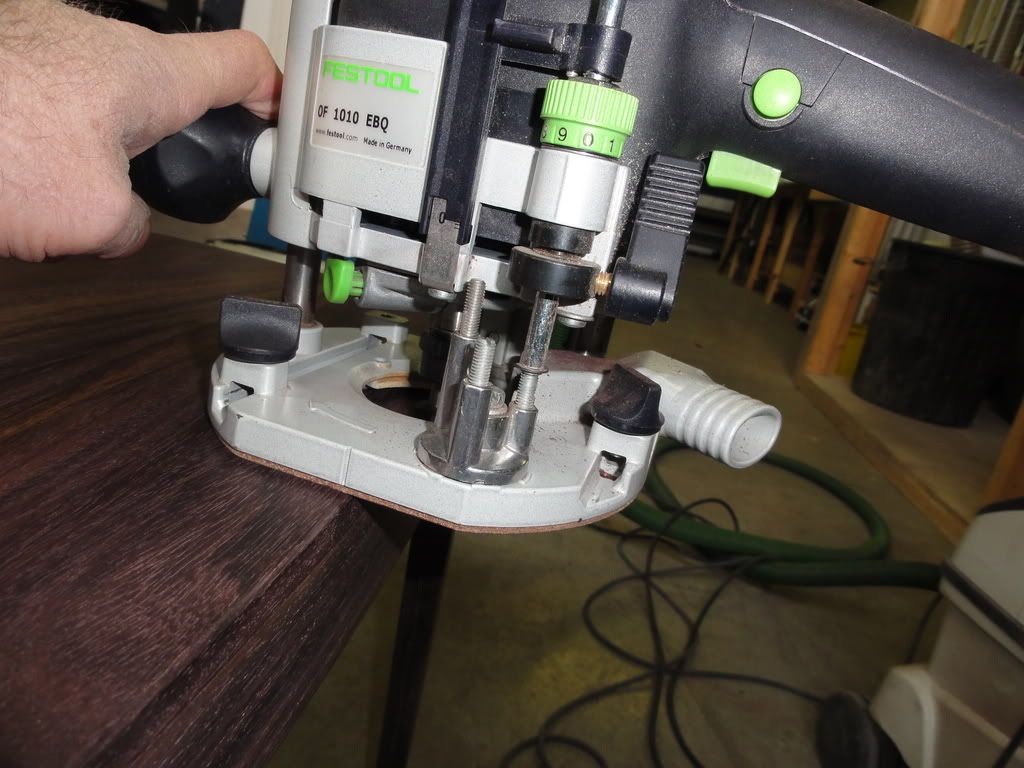
Apart from this, I have kept as close as possible to the original piece, although I am sure they did not use
dominoes in those days..!! I would be interested in anyones opinions as to how they might have jointed the legs and frame together on the original.
The next stage was to round off the outside edges of the legs, again after some advice from the forum, i used my block plane and
then hand sanded to get the required smooth curve. it worked pretty well.
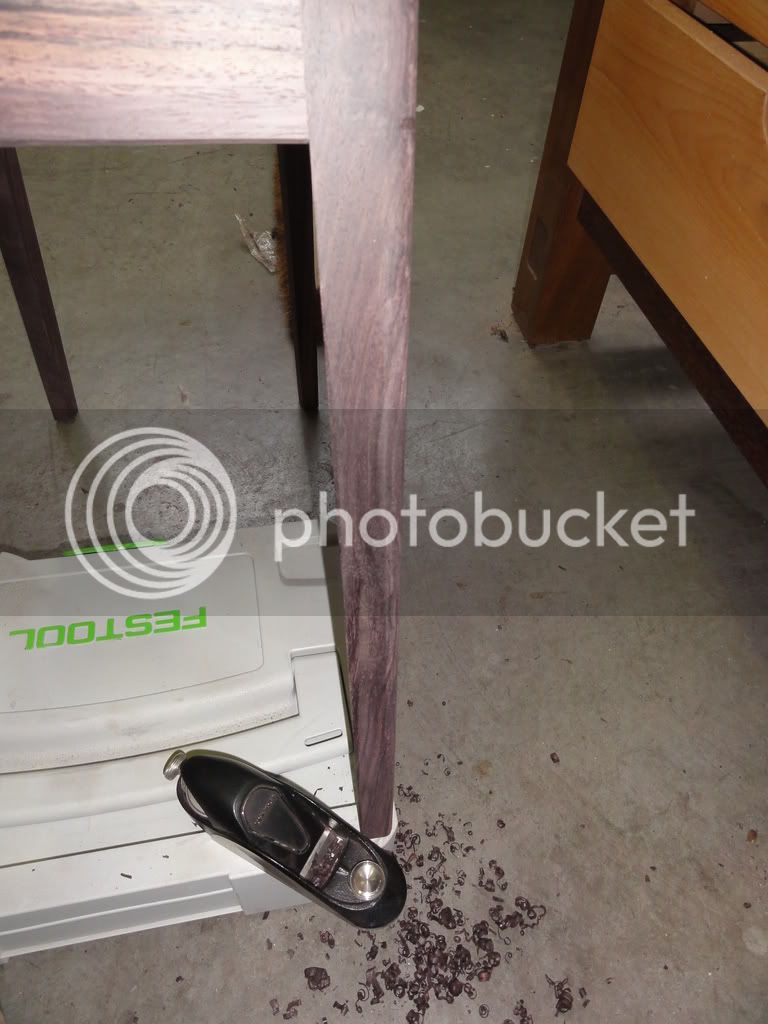
Then set about carefully sanding the whole thing, gradually working up to 240 grit, then using scotchbrite pads to finish.There were lots of awkward little corners and joins underneath to clean off and smooth, which took some time, but the rosewood comes up a treat with some care and elbow grease.
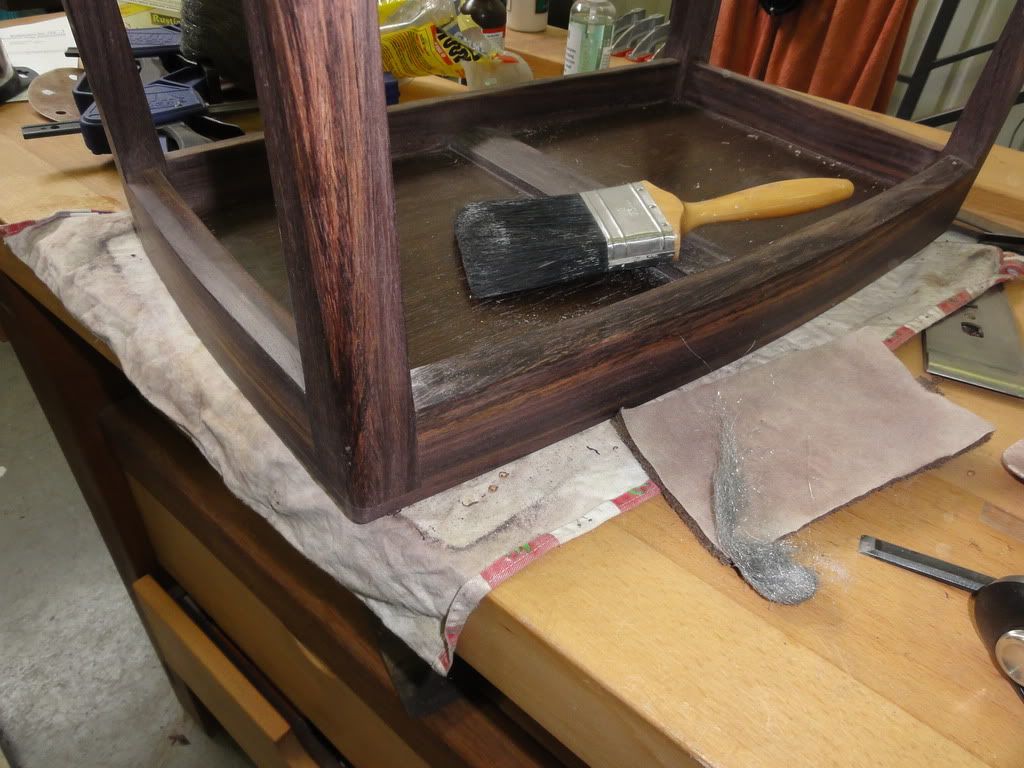
I decided to use the new festo oil system to finish it with, it has a really nice texture and drys quickly, followed off by some
renaissance wax rubbed on with fine wire wool and carefully buffed off. The result was very pleasing in texture and shine.
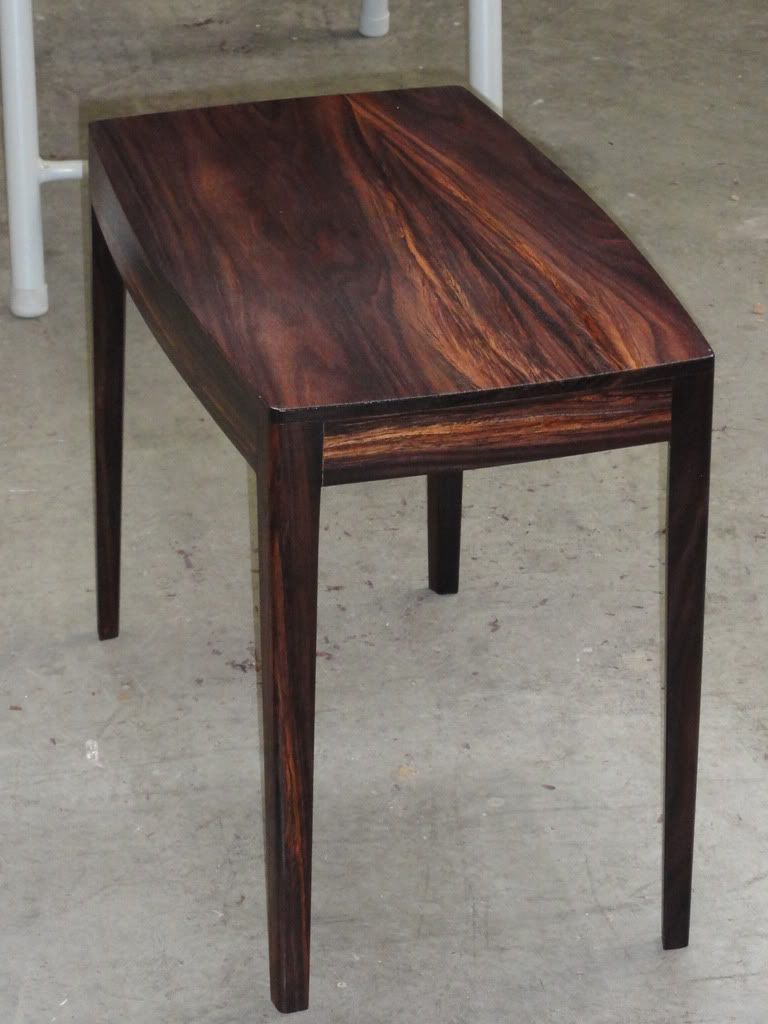
All in all, it took me approx 4 days work to make I think. I must admit, I am very pleased with how it turned out, considering it
is the first piece of proper furniture I have made ( my past projects have been some boxes - this was much more complicated) and
it has inspired me to try some more challenging work next project, along the same lines.
And finally, here it is, sitting under the dressing table, as it will be used.

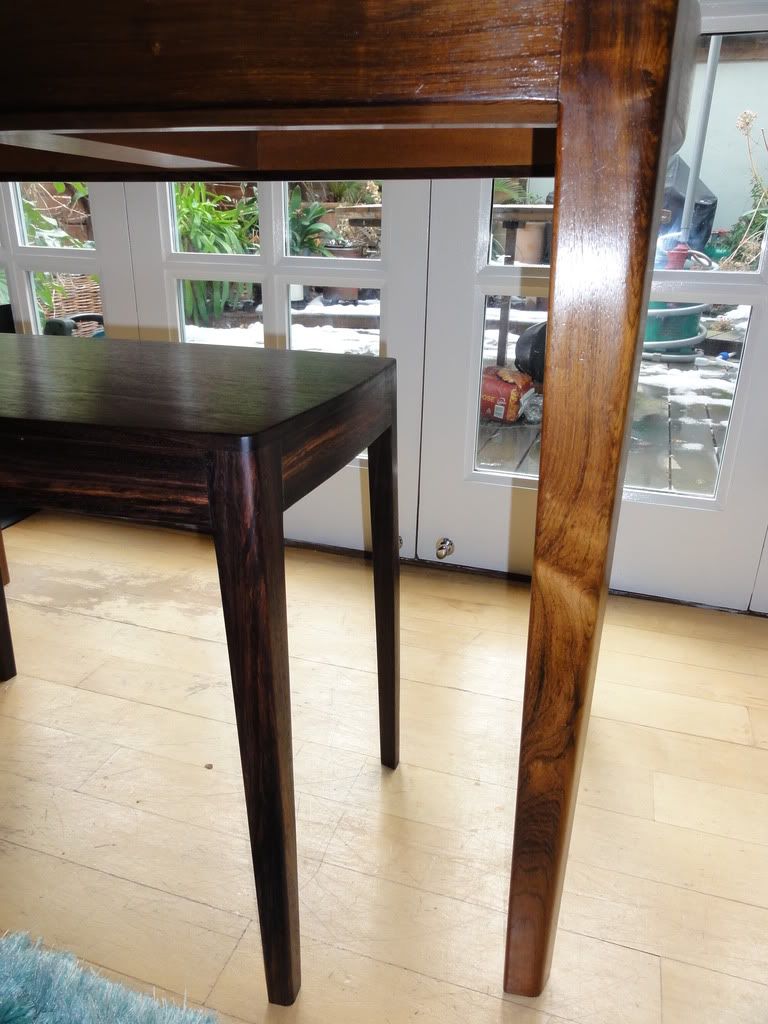

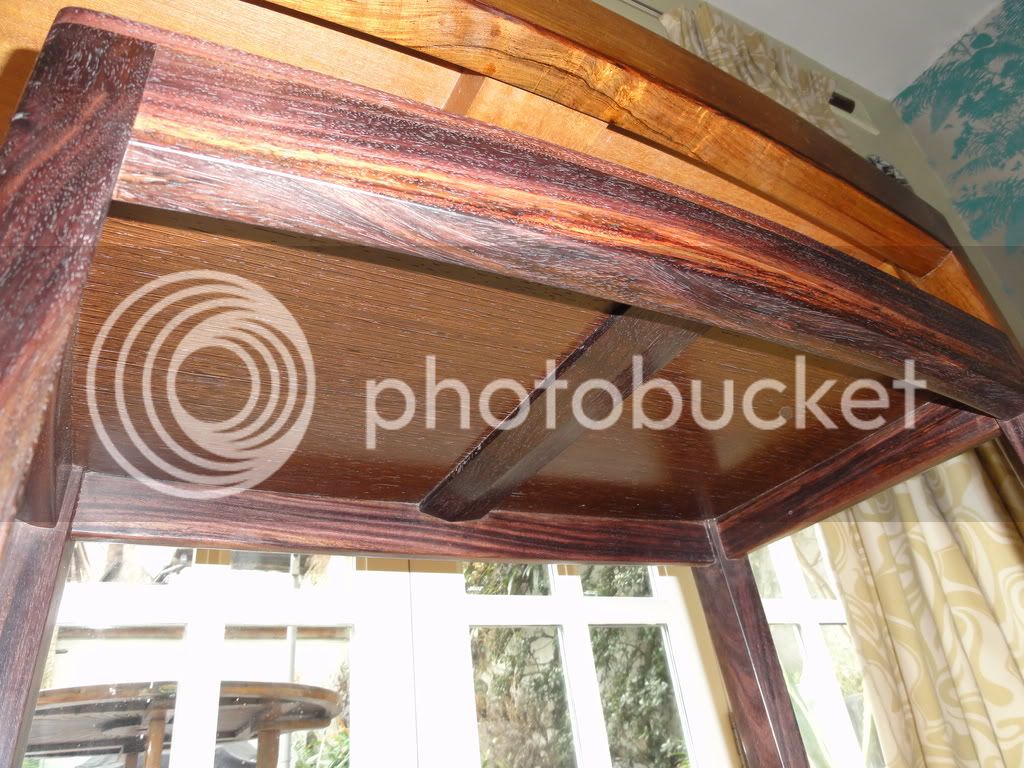
Hope you enjoyed my project, Cheers, Mark
dressing table, see here: http://www.ebay.co.uk/itm/1960s-English ... 0558133282 As you
can see, a very elegant and fetching design with some lovely touches. SWMBO asked if I could make a matching stool and after a
quick look, said, yes, of course!!!
So, ordered up some Indian Rosewood ( it looked like the nearest match from the picture on the website) from exotic hardwoods
(great company and service BTW) but it looked very different to the rosewood of the stool when it arrived, I think the Santos
Rosewood would have been a better match. We decided to go ahead however, as the Indian Rosewood was gorgeous, almost ebony like,
with amazing lighter coloured grain patterns and a purpley hue to some of it.
I carefully scaled down the measurements of the dressing table to make sure the stool matched it in proportions and made my
cutting list. First job, fire up the bandsaw and rough cut the stock to size. The more i thought about the table and its
construction the more I realized that this was not going to be straightforward. The legs are elliptical tapered shapes with
rounded off corners, of two different profiles. The side rails are curved and profiled and the top has a small bead around the
edge to avoid showing end grain. Talk about in at the deep end........Still, I like a challenge !
I started making the legs first, and used my taper jig ( taken from " The resourceful woodworker" a fantastically useful book if
you can get it..)

The first pass was easy, but both planes required tapering and here was where it got tricky....... I eventually
figured out how to pack the leg and reverse the cut, also allowing for the thickness of the blade using the off cut. However,
before I started on the rosewood, as there was no spare, I decided to make a couple from softwood so I had the method and jig
correctly sorted out in advance. This proved a good decision as I went through several softwood versions while figuring it out.


Eventually I was happy that I had it sussed and with bated breath cut the first leg for real. It worked!!! I see Woodmonkey used a
jointer to do his tapered legs in the thread about his table, so I might look in to that method as well. After this, I then had to
plane 2 faces of each leg a few degrees under a right angle at the top, and lose it down the taper, to follow the line of the
curved side pieces. Not easy clamping a tapered in 2 planes leg in a vice solidly enough to plane rosewood effectively.... a few
choice words were uttered as the legs kept working themselves loose from the packed and shimmed arrangement as I planed
particularly forcefully..!!! Eventually though, it was all done.
Next stage was to make the side rails. As they were curved,I decided to cut the stock thicker and actually cut the shape of the
curve on the bandsaw. I used a piece of Corian held at tension, to give the required curve to trace out with a felt pen on to the
wood.

When they were cut out roughly, I planed off the excess as best I could

and then set to work with the Rotex sander and some 40 grit paper to shape the inner and outer curves properly. This was not as easy as it sounds and took ages, and it is really difficult to get the curve right in all the dimensions, especially as its all too easy to take off more than you needed in one area with the Rotex and some 40 grit...Once I had the shape right, i worked back up to 240 grit to smooth it all off.


The next stage was the top. I had to resaw and thickness the stock to about 12mm each piece, to get the required size pieces to
make a big enough panel for the top. After jointing up on the machine and finishing with the big number 6 stanley, they dry fitted
nicely, so I used the smallest dominoes and glued them together and clamped up to dry.

and the finished top piece

Then came the first pause for reflection.... how was I going to strongly and accurately join it all together. I must confess to
not really thinking this through properly at the beginning and now realized that using the domino jointer was going to be really
tricky, due to the fact that not one of the faces were parallel, at right angles to one and other, or straight....hmmmmm.. I
posted in the general forum and the general consensus was use the domino and some careful packing and shimming. Again, I was
careful to try it on some scrap first, and then on the real thing. It was tricky and awkward, but worked...phew...
Then, on to cutting the correct angle to match the taper of the legs and the trapezoid shape on each end of the side rails.

This again was not easy as it a raked and angled cut on a curved piece of stock, that varied slightly on each leg, as I had planed
these by hand. I ended up creeping up on each cut individually until they all fitted just right.

Then, it was the dry assembly to check how it fitted, and it all looked good.

At this point I decided that I should also have a centre rail support, as the stool was going to be sat on, the top was only 12mm
thick and there was the danger that it would sag under the weight of SWMBO ( A svelte 9 stone I hasten to add....! but even so,
possibly enough to break the glue join) . So from the one remaining off cut, I made a centre rail, with a nice angled face, and
dominoed it to the side rails.
I also decided that I would need to provide some additional strength to the whole thing, and also
the largest glueing area possible for the top, which would just have to be glued on. So, I decided to rout out down to 12mm depth
the frame, using my Festo adjustable routing template ( very useful bit of kit) ,

and drop in two panels made from some Wenge veneered MDF , which went with the rosewood quite nicely. This meant that the top could now be glued down completely over its whole area, rather than just where it met the rails.


This done, I glued it all up and used a ratchet and nylon strap to clamp it all together overnight, using Titebond ultimate.

Once this was glued, the last piece of construction was to fit the top to the structure.


I cut it slightly oversized on the bandsaw,
after laying it over the frame and then glued up. I cut a piece of ply to fit under the stool, to give me something to clamp to,
and then set about clamping the top on. I think I used all my clamps, as you can see from the picture, there was not much room
left around the edge! I left it for nearly 2 days before unclamping.

Then, I used a bearing guided straight cutter to follow the shape of the frame and routed off the overhang.

After that, I used a small radius bearing guided cutter, to round over the edge. I had considered replicating the shaped bead used on the original, but was unsure how easy it would be to bend to shape and also the end grain did not look at all bad, so in the end decided not to
include this feature.

Apart from this, I have kept as close as possible to the original piece, although I am sure they did not use
dominoes in those days..!! I would be interested in anyones opinions as to how they might have jointed the legs and frame together on the original.
The next stage was to round off the outside edges of the legs, again after some advice from the forum, i used my block plane and
then hand sanded to get the required smooth curve. it worked pretty well.

Then set about carefully sanding the whole thing, gradually working up to 240 grit, then using scotchbrite pads to finish.There were lots of awkward little corners and joins underneath to clean off and smooth, which took some time, but the rosewood comes up a treat with some care and elbow grease.

I decided to use the new festo oil system to finish it with, it has a really nice texture and drys quickly, followed off by some
renaissance wax rubbed on with fine wire wool and carefully buffed off. The result was very pleasing in texture and shine.

All in all, it took me approx 4 days work to make I think. I must admit, I am very pleased with how it turned out, considering it
is the first piece of proper furniture I have made ( my past projects have been some boxes - this was much more complicated) and
it has inspired me to try some more challenging work next project, along the same lines.
And finally, here it is, sitting under the dressing table, as it will be used.




Hope you enjoyed my project, Cheers, Mark

































